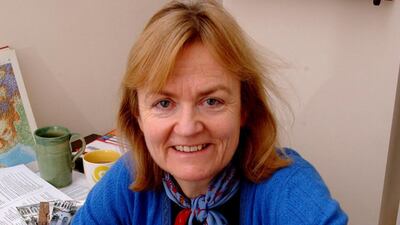The Middle East "held a fascination for me since childhood. I mean, it's where civilisation began", engaging conversationalist, British writer and historian Diana Darke says of her lifelong entanglement with the Arab world. Her second book, The Merchant of Syria, is published this month.
After studying Arabic in the 1970s, she spent six months in Beirut. This is when – through a series of cross-border visits – she first fell in love with Syria. "I was a 22-year-old blonde woman travelling alone, and I was completely safe. Everybody was courteous and welcoming," she recalls.
Damascus in particular captured her heart – "You breathe the history as you walk the streets" – so much so that she wrote a Bradt guidebook to the city. Years later, she struggled through Syria's notorious bureaucratic hurdles to buy and restore a 17th-century Old City home. Her first book – My House in Damascus (2016) – is an affecting account of this process.
The house was initially inhabited by friends displaced from the besieged area of Ghouta. Then, after a corrupt lawyer wrote a security report describing Darke as "a British terrorist", the house was seized by profiteers. Undaunted, she returned in 2014 to reclaim it.
Her books interweave contemporary and historical events, providing a long-range perspective that she deems “more important than ever. Because today, everybody has short memories. The media works on immediacy – blood and gore. It distorts people’s view of the area, which across the centuries has been this incredibly open, tolerant, embracing place – and largely because of trade”.
The Merchant of Syria is in part the biography of Abu Chaker Chamsi-Pasha, who began his career at 10, after his father's death, running the family textiles shop in Homs. He went on to run one of Britain's biggest textile companies.
The book's subtitle is A History of Survival. Dodging the United Arab Republic's nationalisations, Chamsi-Pasha shifted to Lebanon in 1959. At the outbreak of Lebanon's war, his warehouses were looted, but banks extended him credit simply on the basis of trust. He used it to buy stock directly from the United Kingdom to supply the souqs of the Gulf.
In 1981, he moved into Yorkshire’s struggling textiles industry, buying the giant Hield and saving its Bradford mills.
Alongside this story of personal survival, Darke recounts Syria's economic history. Her intriguing argument is that commerce has always acted as the social glue joining different communities. Instead of the rural-urban divide, she focuses on the "grain-trade alliance", which her "archetypal Syrian merchant" embodied through his co-operative social network.
She admiringly describes the waqf system integrating religion, trade and public welfare, and sees Islam's traditional "moral economy" as a more humane variant of capitalism. "The surplus is put back into the community," she tells me. "Mutual support is built into the system. Nobody talks about giving to charity. It's just the way things are done. It's the opposite of our contemporary corporate cut-throat culture."
In Chamsi-Pasha's Homs, Christian traders were as supported as Muslims. Peaceful interchange between the country's various groups has been the rule, Darke says, "precisely because of political turbulence, because the state – from at least the French period on – was rapacious, it meant communities had to work together to solve problems. And they usually did". At its best, this produced a form of multiculturalism proving "that the strength of society lies in everybody, from every background, bringing something to the table".
________________________
Read more:
'Syria: A Conflict Explored' exhibition brings to light harsh realities of war
Can technology help restore Syria's lost archaeological heritage?
Healing the hurt in Syria one stitch at a time
________________________
Chamsi-Pasha resettled in Homs in 1999. He left for the last time in 2011, at the age of 89, and died two years later, having watched the destruction from afar.
The war seems to have undone the strong social bonds that Darke praises. Today, she warns that extremism will continue "as long as a government remains that the majority of the population cannot respect, trust or depend on", and hopes for a future in which "the motivation for wealth creation is shared benefit, not personal enrichment". The long historical perspective sometimes makes it seem that Syria is fated to eternal repetition. Evidence is presented of repeated destruction (Emessa – ancient Homs – was also "thoroughly destroyed"), resistance (in 1925, "broad coalitions of Syrians" fought the French), and repression (assisted by foreign mercenaries, the French then burnt Ghouta). I ask Darke if this focus on continuity also contained a message of hope.
“It’s the worst it’s ever been,” she says. “Syrians will have to fight incredibly hard to overcome it. But society will survive. It’s not going to be permanently pushed under by this current phase. My grandfathers – one German, one English – fought in opposite trenches in the First World War. Some years later their children married. There’s a lesson here.”

